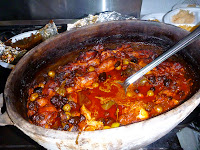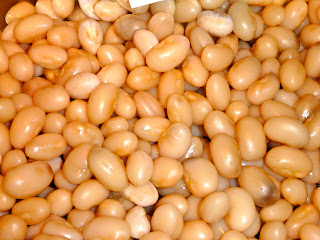The recipe I want to share is adapted from "One Bite at a Time - Nourishing Recipes for Cancer Survivors and Their Families" by Rebecca Katz. Rebecca is a nationally recognized expert in using food as medicine. Her book is inspiring and filled with recipes that are beneficial for everyone. What I love about this recipe is not only that it is balanced and healthy, but also that it is extremely versatile and can be easily adapted according to what you have available in your pantry and what is in season.
Seasonal Couscous
Squash:
1/4 tsp ground cumin
1/4 tsp ground coriander
1/4 tsp sea salt
1/8 tsp ground cinnamon
2 Tbls olive oil
2 C. peeled and diced acorn squash, butternut squash, sweet potato, or a combination
Couscous:
1 C. couscous
1 Tbls olive oil
1 Tbls diced shallot
3 Tbls diced fennel
1/2 C. dried cranberries, currants, or a combination
pinch of red pepper flakes
1/4 tsp ground cumin
1/4 tsp ground coriander
1/4 tsp sea salt
To make the squash, preheat the oven to 350 degrees.
In a large bowl, mix the cumin, coriander, salt, cinnamon, and olive oil. Toss the diced squash in the mixture to coat well. Roast on a rimmed sheet pan for 15 minutes, or until just tender, shaking the pan once so the squash cooks evenly. Remove from the oven, cool, and set aside.
To make the couscous, combine the couscous and 1 C. boiling water in a large bowl and immediately cover tightly with a lid. Let it sit for 10-15 minutes, or until the moisture is absorbed. Place the couscous on a sheet pan and spread it out with a fork, raking several times while cooling to keep the grains from clumping.
While the couscous is cooling, heat the olive oil in a large sauté pan. Add the shallot and fennel and cook until soft. Add the dried cranberries, red pepper flakes, cumin, coriander, and salt. Stir well.
When the couscous has cooled, add the shallot mixture and squash. Stir well and add a squeeze of lemon juice if desired.
Serve at room temperature.
Serves 4.
As I mentioned above, this recipe lends itself well to your creativity. Couscous is a nutritious alternative to pasta and rice but if you want even more nutrition use Quinoa instead of couscous. Quinoa (pronounced "Keen-wah") are edible seeds from an ancient grass. It originates from South America and was a sacred crop of the Incas. Quinoa is chock full of essential amino acids, making it a complete protein, one of few in the plant kingdom. It is also high in fiber, minerals, and it is gluten free. Kind of a wonder food really! Quinoa is light and fluffy when cooked and its mild and slightly nutty flavor makes it a healthy substitute for white rice or couscous. You can find Quinoa readily in any grocery store. Simply follow the directions on the box to cook and then substitute for the cooked couscous in the recipe above.
 |
| Couscous |
 |
| Red Quinoa |
Nuts are a great addition to this dish as well. You can buy black walnuts and hickory nuts locally from our farmer's markets, or harvest your own. Pistachios, almonds, and pine nuts also make a great addition. Be sure to toast the nuts before adding them to your dish for better flavor.
Toasting nuts: heat dry skillet (skillet should be large enough to accommodate nuts in a single layer) over medium-high heat, add nuts, toast the nuts shaking the pan often to toast evenly. This takes only a few minutes and the nuts can burn quickly, so do not walk away from the stove while doing this. When nuts are lightly browned and fragrant remove from heat and skillet to stop cooking.
Other ideas: If you don't have shallots you can use onion and garlic. In the spring try adding asparagus and fresh sauté greens to the mix. Through the summer use zucchini and summer squashes instead of winter squash and toss in cherry tomatoes. Try playing with fresh herbs as well. Fall brings us hearty greens like spinach and kale, leeks, and we start seeing the winter squashes again. Apples would add a fun sweet tart flavor too. Don't be afraid to get creative!! I have occasionally also added some feta or goat cheese and other times a simple vinaigrette. Vom Fass is a great place to get fun oils and vinegars to brighten up any salad!
If you skipped to the end, here is the important information I was talking about. ;)
Believe it or not our winter farmer's markets are teeming with fresh produce and storage vegetables alike. Many of our local farmer's now have hoop houses to bring us beautiful spinach and salad greens in the middle of January. Winter eating in Wisconsin has never been so good! For those of us who like to grow some of our own food the winter lull is about over and it's time to start our garden planning. If you are a vegetable or flower gardener don't miss the Garden Expo coming up February 10-12th! There are experts galore offering their advice and knowledge across a wide range of topics for bargain prices. If growing your own food just isn't a part of your life, you must consider investing in a CSA. Most local HMOs now even offer a reimbursement from your health insurance to help cover the cost. Another jewel of an expo (of sorts) is MACSAC's CSA open house coming up on Sunday, March 18th. If you have ever been curious about CSAs or are in the market and want to shop your options you should not miss this event!
I would love to hear what seasonal dishes you are cooking up in your kitchens! Please post in the comments. :)






















